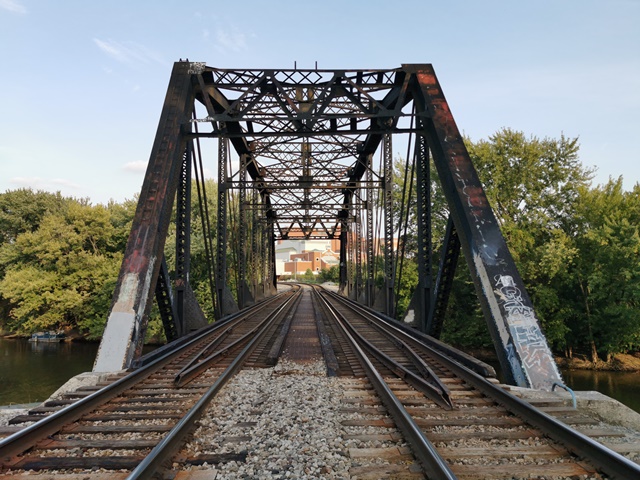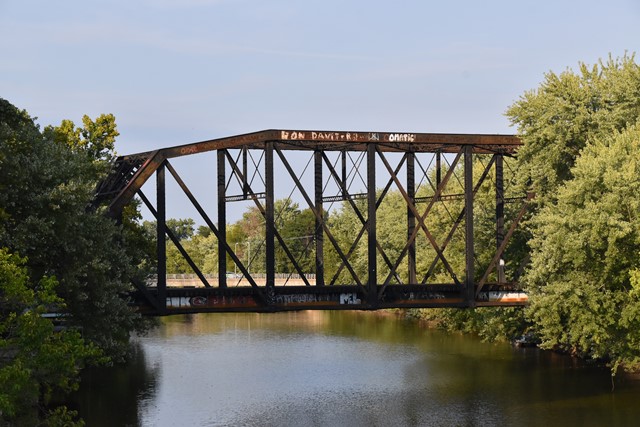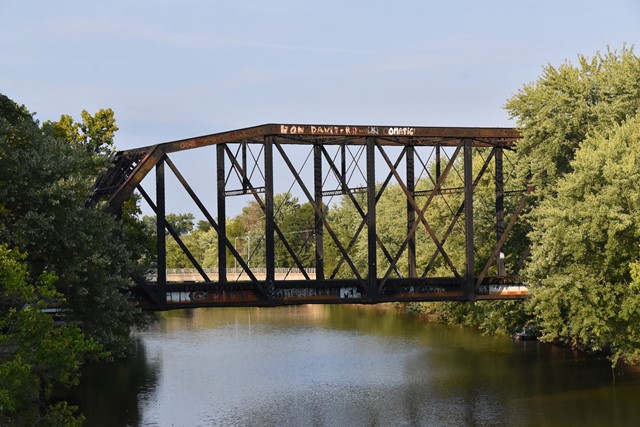We Recommend:
Bach Steel - Experts at historic truss bridge restoration.
BridgeHunter.com Phase 1 is released to the public! - Visit Now
Fort Wayne Railroad Bridge

Primary Photographer(s): Nathan Holth
Bridge Documented: April 2, 2006 and September 21, 2019
Fort Wayne: Allen County, Indiana: United States
1904 By Builder/Contractor: King Bridge Company of Cleveland, Ohio
Not Available or Not Applicable
185.0 Feet (56.4 Meters)
190.0 Feet (57.9 Meters)
Not Available
1 Main Span(s)
Not Applicable

View Information About HSR Ratings
Bridge Documentation
This bridge was built in 1904 and is an uncommon example of a pin-connected Camelback railroad truss. Aside from the uncommon use of the Camelback truss design, the bridge is traditionally composed. The bottom of the portal bracing appears to have been replaced/altered perhaps to increase vertical clearance on the bridge. The bridge is also noted for its skew, uncommon for pin-connected truss bridges.

Information and Findings From DHPA Historic Bridge SurveyStatement of Significance The heaviness, skewing, diagonal reversal, and truss pattern are all unusual features of this structure. The span retains its original members and substructure. Architectural Description Seated upon cut stone abutments and wingwalls, this single-span pin-connected Camelback is divided into seven panels by verticals of reverse channels laced to one another. The heaviness of the structure is evident in the crafting of the channels and the cover plates used for the endposts and top chord. Heavy diagonals (reversed laced channels) pinned midway into the endposts stabilize the abutment panels which are of different size to adjust for off-setting the south truss by about 6' to the west. The use of cylindrical and die-forged eyebars as diagonals in the three center section panels is reversed in the opposite truss: Double die-forged eyebars are countered with cylindrical ones with turnbuckles (doubled in the most central panel). The top chord for each of the two side panels has a different slope. The typical and yet heavier double die-forged eyebars angle from the top pins downwards towards midspan, although the panel close to the center section also has an adjustable counter. The heavy girder floor beams are riveted to the vertical above the lower chord. They, in turn, have heavy girder stringers riveted to the floor beams. Bridge Considered Historic By Survey: Yes |
![]()
Photo Galleries and Videos: Fort Wayne Railroad Bridge
2019 Bridge Photo-Documentation
Original / Full Size PhotosA collection of overview and detail photos. This gallery offers photos in the highest available resolution and file size in a touch-friendly popup viewer.
Alternatively, Browse Without Using Viewer
![]()
2019 Bridge Photo-Documentation
Mobile Optimized PhotosA collection of overview and detail photos. This gallery features data-friendly, fast-loading photos in a touch-friendly popup viewer.
Alternatively, Browse Without Using Viewer
![]()
2006 Bridge Photo-Documentation
Original / Full Size PhotosA collection of overview and detail photos. This gallery offers photos in the highest available resolution and file size in a touch-friendly popup viewer.
Alternatively, Browse Without Using Viewer
![]()
2006 Bridge Photo-Documentation
Mobile Optimized PhotosA collection of overview and detail photos. This gallery features data-friendly, fast-loading photos in a touch-friendly popup viewer.
Alternatively, Browse Without Using Viewer
![]()
Maps and Links: Fort Wayne Railroad Bridge
Coordinates (Latitude, Longitude):
Search For Additional Bridge Listings:
Bridgehunter.com: View listed bridges within 0.5 miles (0.8 kilometers) of this bridge.
Bridgehunter.com: View listed bridges within 10 miles (16 kilometers) of this bridge.
Additional Maps:
Google Streetview (If Available)
GeoHack (Additional Links and Coordinates)
Apple Maps (Via DuckDuckGo Search)
Apple Maps (Apple devices only)
Android: Open Location In Your Map or GPS App
Flickr Gallery (Find Nearby Photos)
Wikimedia Commons (Find Nearby Photos)
Directions Via Sygic For Android
Directions Via Sygic For iOS and Android Dolphin Browser
USGS National Map (United States Only)
Historical USGS Topo Maps (United States Only)
Historic Aerials (United States Only)
CalTopo Maps (United States Only)



